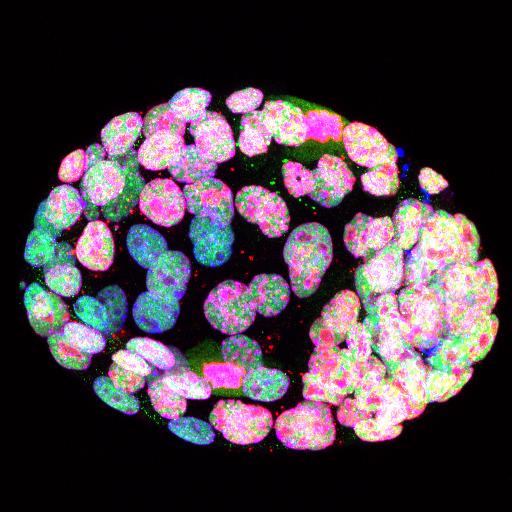
This is a dormant mouse blastocyst. After a gestation period of around ten months, fawns are born in early summer - when the weather is warm and food is plentiful for the mother. Six months would actually be enough for the embryo's development, but then offspring from mating in the later portion of summer would be born in winter. Therefore, nature prolongs the gestation period by a hormone-regulated pause in the development of the early embryos. Many animal species use this process, called diapause, to adjust their reproduction to environmental conditions.
In their research on embryonic stem cells, Andreas Trumpp and colleagues have now discovered the factor that controls this developmental pause. Trumpp is head of a research department at the DKFZ and of Heidelberg Institute for Stem Cell Technology and Experimental Medicine (HI-STEM), which is based at the DKFZ and supported by the Dietmar Hopp Foundation.
It is known in many types of cancer that the more MYC they produce, the more aggressively the tumors grow. The scientists had noticed that MYC is also active in embryonic stem cells. In order to explore the role that the gene plays in these cells, the investigators obtained embryonic stem cells from mice whose MYC genes (c-MYC and N-MYC) they could selectively deactivate. The resulting embryonic MYC-depleted stem cells strongly reduced the activity of genes that play a role in cell division, cellular growth and metabolism. However, the dormant cells stayed alive and retained their identity as stem cells: they continued producing the important "stem cell factors" that enable them to differentiate into the more than 200 cell types of the body.
Using a chemical substance that inhibits MYC, the scientists were able to show that this biochemical dormancy is reversible. When they stopped giving the inhibitor, the cells immediately resumed RNA, protein and DNA synthesis and were able to proliferate infinitely.
Inhibiting MYC activity arrests embryonic development
"The biochemical dormancy of MYC-depleted stem cells reminded us strongly of the process of diapause, which has remained completely elusive so far," says Roberta Scognamiglio, who is the first author of the study. "In this process, too, embryos in the early development state, called blastocysts, enter a dormant state without growth and almost without metabolism prior to nidation in the uterus." In order to find out whether these two phenomena have the same cause, the researchers compared the activity of all genes in MYC-depleted embryonic stem cells with those in diapaused mouse blastocysts. In both cases, the groups of genes that were inactive besides MYC primarily controlled protein synthesis and cell growth. The stem cell factors, however, continued to be produced unchanged.
When the researchers treated normal blastocysts in the Petri dish with the MYC inhibitor, they fell into a diapause-like state. These dormant embryos were subsequently transferred into surrogate mother mice and grew to become normal young animals.
"To induce diapause or to put embryonic stem cells into a dormant state, it is therefore sufficient to deactivate the MYC oncogene," Trumpp summarizes. "This does not affect the potential of stem cells. This is a very special property of stem cells, because all other cell types die after MYC inhibition."
Trumpp thinks that MYC can also have a disastrous effect on cancer stem cells, particularly on dormant metastasis stem cells. When they migrate through the bloodstream to distant organs, they may come under the influence of signaling molecules that form, for example, in inflammatory processes. These might stimulate their MYC production and thus cause them to grow into metastases. "We now try blocking MYC as a strategy to control these dangerous sleepers," the stem cell researcher says.
Source: German Cancer Research Center (Deutsches Krebsforschungszentrum, DKFZ)
 Print Article
Print Article Mail to a Friend
Mail to a Friend
